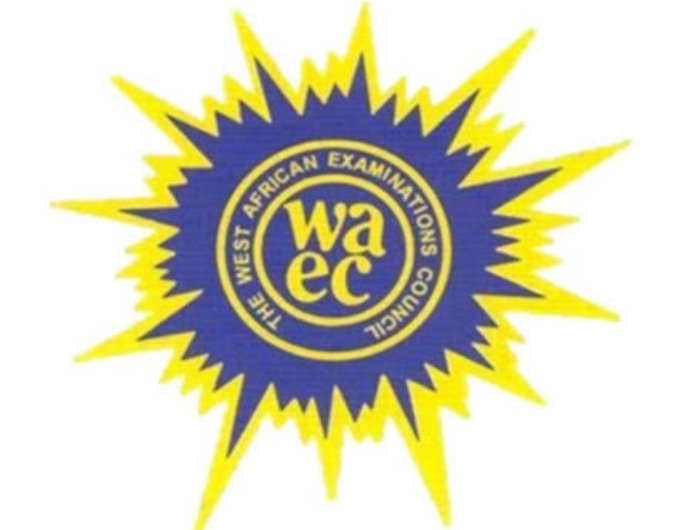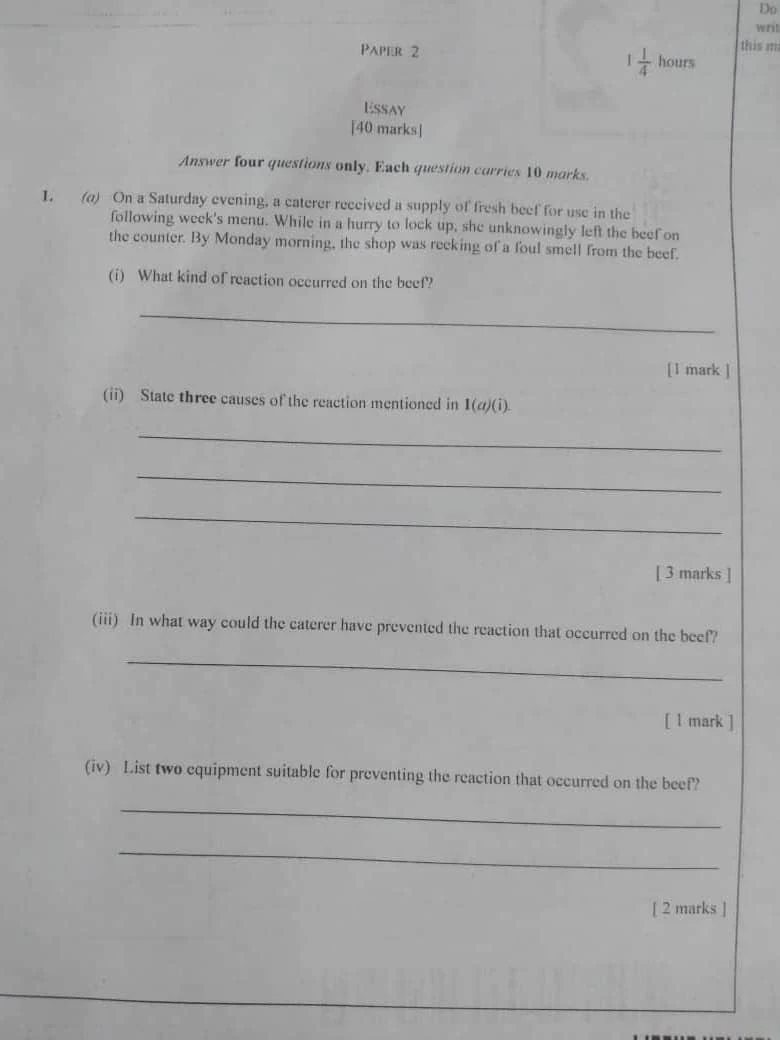2025 WAEC Food and Nutrition Exam OBJ (Objectives) and ESSAY (Theory) Questions and Answers EXPO Room for School Candidates and Private Candidates. WAEC Food and Nutrition OBJ and ESSAY Questions and Answers, 2025 WAEC Free Question and Answer Room for Food and Nutrition OBJ and Theory.

The West African Examinations Council (WAEC) has provided the 2025 WAEC Food and Nutrition Exam OBJ (Objectives) and ESSAY (Theory) Questions and Answers EXPO Room for School Candidates and Private Candidates. This resource includes both objective and theory questions, helping students prepare effectively and confidently for the WAEC GCE Nov/Dec and May/June 2025/2026 examination.
📘 Join Our WAEC Exam Room
Get live updates, likely questions, and connect with other students preparing for
WAEC Food & Nut 2026 and other subjects.
2025 WAEC food and Nutrition questions paper






2025 WAEC Food and Nutrition Essay (Theory) Answers
Question 3
(3a) Definitions:
(i) Table Appointments: Items placed on the dining table to enhance the dining experience, such as tablecloths, napkins, placemats, cutlery, glassware, and dishes.
(ii) Table Setting: The arrangement of tableware and utensils for each diner. This includes the placement of plates, forks, knives, spoons, glasses, and napkins according to dining etiquette.
(iii) Centerpiece: A decorative item placed at the center of a dining table, serving as a focal point. It can include floral arrangements, candles, fruit bowls, or themed ornaments.
(3b) Examples of Tableware (Pick Any Two):
(i) Plates
(ii) Bowls
(iii) Cutlery
(iv) Glassware
(3c) Uses of Napkins (Pick Any Two):
(i) Used for wiping hands and mouth to maintain cleanliness during and after meals.
(ii) Placing a napkin on the lap indicates good manners and signals the start of the meal.
(iii) Helps to blot or clean food stains from clothing or face.
(iv) Protects clothing from spills when placed over the lap.
(v) Placing a napkin beside the plate can signal the end of a meal.
Question 4
(4a) Importance of Fruits for Adolescents (Pick Any Three):
(i) Fruits provide essential vitamins and minerals that support growth.
(ii) Their high fiber content aids digestion and prevents constipation.
(iii) Antioxidants in fruits strengthen the immune system against infections.
(iv) Promote healthy skin and protect against damage.
(v) Natural sugars offer a quick energy boost for active adolescents.
(vi) Fruits help in weight management and prevent obesity due to their low calorie and high water content.
(4b) Ingredients for Preparing Fruit Fool (Pick Any Three):
(i) Fresh fruits
(ii) Sugar or sweetener
(iii) Whipped cream or Greek yogurt
(iv) Lemon juice
(v) Vanilla extract
(4c) Preparation of Fruit Fool:
Chop the fresh fruits and mix them with sugar. Gently fold in whipped cream or Greek yogurt. Add lemon juice and vanilla extract for added flavor. Layer the mixture into serving glasses and chill. Garnish with mint leaves or grated chocolate before serving.
Question 5
(5a) Examples of Protein-Rich Foods:
(i) Meat (beef, pork, poultry)
(ii) Fish (salmon, trout, tuna)
(iii) Dairy products (milk, yogurt, cheese)
(iv) Nuts and seeds (almonds, sunflower seeds)
(v) Whole grains (oats, quinoa)
(vi) Legumes (lentils, chickpeas)
(5b) Effects of Phosphorus Deficiency (Pick Any Four):
(i) Leads to feelings of weakness and fatigue.
(ii) Can cause a decreased appetite or loss of interest in eating.
(iii) May result in bone and joint pain.
(iv) Can lead to irritability and mood changes.
(v) Causes difficulty concentrating and cognitive impairment.
Question 6
(6a) Tips for Planning a Special Occasion (Pick Any Four):
(i) Determine your budget for the venue, food, decorations, etc.
(ii) Choose a location that can comfortably accommodate your guest list and fits the theme.
(iii) Select a theme that reflects the couple’s style and personality.
(iv) Choose a menu that caters to guests’ preferences.
(v) Plan activities or entertainment to keep guests engaged.
(vi) Decide on the guest list and ensure the number aligns with your capacity.
(6b) Serving Styles for Events (Pick Any Four):
(i) Buffet style
(ii) Family style
(iii) Food stations
(iv) Cocktail style
(v) BBQ/grill style
(6c) Types of Glassware for Events (Pick Any Two):
(i) Wine glasses
(ii) Champagne flutes
(iii) Highball glasses
(iv) Lowball glasses
(v) Mason jars or tumblers
Recommended Posts
Foods and Nutrition Syllabus
- Good food promotes health and energy
- Students need to learn how to select, prepare, and cook healthy food
- Foods and Nutrition as a subject prepares students for careers in the food industry and encourages creativity in using local ingredients
Aims and Objectives
| Objectives | Description |
|---|---|
| a | Acquire basic knowledge about foods and nutrition |
| b | Understand the relationship between nutrition and health |
| c | Identify career opportunities and acquire skills for further studies |
| d | Plan, select, prepare, and serve food for different occasions |
| e | Understand the importance of a safe and efficient kitchen |
| f | Choose, use, and care for kitchen equipment and tools effectively |
| g | Appreciate the importance of sanitation in food preparation and service |
| h | Apply principles of food processing, storage, and preservation |
| i | Acquire basic knowledge of consumer education |
| j | Develop research skills and experiment with local dishes |
| k | Set up a business in the food industry using acquired skills |
Scheme Of Examination
| Paper | Format | Time | Marks | Additional Information |
|---|---|---|---|---|
| Paper 1 | Multiple Choice Questions (60) | 1 hour | 60 | – |
| Paper 2 | Essay Questions (6, answer 4) | 1 hour 15 minutes | 40 | – |
| Paper 3 | Practical Test | 3 hours | 100 | Conducted by a visiting examiner |
Detailed Syllabus: Nutrition and Health
| S/NO | Topic | Sub-Topics |
|---|---|---|
| 1 | Introduction to Foods and Nutrition | – |
| 2 | Careers associated with Foods and Nutrition | a) Careers b) Factors influencing career choices c) Required characteristics |
| 3 | Basic Food Nutrients | a) Meaning b) Basic knowledge of Nutrition c) Importance of Human Nutrition d) Factors affecting Foods and Nutrition e) Food Habits |
| 3 (contd.) | Nutrients and their nutritive values | a) Nutrients and their functions b) Sources of different nutrients c) Dietary deficiencies d) Metabolism (digestion and absorption of foods) e) Food composition table f) Food tests (simple physical and chemical tests) |
| 4 | Meal Management | a) Meal Planning b) Special Nutritional Needs |
| 4 (contd.) | Meal Planning | a) Meal planning terms b) Reasons for planning meals c) Factors in planning meals d) General principles of meal planning e) Meal patterns |
| 4 (contd.) | Special Nutritional Needs | a) Nutritional needs for different groups (e.g. pregnant, lactating mothers, infants, children, adolescents, adults, and the aged, vegetarians) b) Planning meals for people in health conditions (e.g. HIV & AIDS, invalids, convalescents, overweight, underweight, hypertension, diabetes, etc.) |
Detailed Syllabus
| S/NO | Topic | Sub-Topics |
|---|---|---|
| II | Food Laboratory and Equipment | 1. The kitchen 2. Kitchen equipment and tools 3. Safety in the kitchen 4. Sanitation in the kitchen |
| II (contd.) | 1. Types of kitchen 2. Planning different types of kitchen 3. Factors to consider when planning 4. Cleaning agents and abrasives | |
| II (contd.) | 1. Classes and types of equipment 2. Selection, use, care, and storage of equipment 3. Types of kitchen accidents 4. Simple first aid treatment | |
| III | Food Commodities | 1. Animal and animal products 2. Cereals/grains 3. Fruits and vegetables 4. Legumes and oily seeds |
| III (contd.) | 1. Fats and oils 2. Starchy roots and plantain | |
| IV | Food Storage and Preservation | 1. Food spoilage 2. Food preservation 3. Food storage |
| IV (contd.) | 1. Meaning and importance of preservation 2. General principles underlying food preservation 3. Methods of food preservation | |
| V | Food Preparation | 1. Principles underlying cooking 2. Methods of cooking 3. Transfer of heat |
Sub-Topics
| Topic | Sub-Topics |
|---|---|
| Food Commodities | Kinds/types and structure Selection Storage |
| Fats and oils | Kinds and classification Uses in diet Uses in the body Health implications |
| Starchy roots and plantain | Types of starchy roots Types of plantain Types of dishes |
| Food Storage | Meaning and importance of food storage Storage of perishable and non-perishable foods Storage space and equipment |
| Food Preparation | Explanation of the concept of cooking Reasons for cooking food Moist heat methods Dry heat methods |
| Transfer of heat | Convection (liquid, gases) Radiation (space) Conduction (solid metal) |


